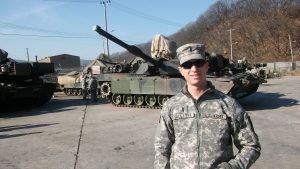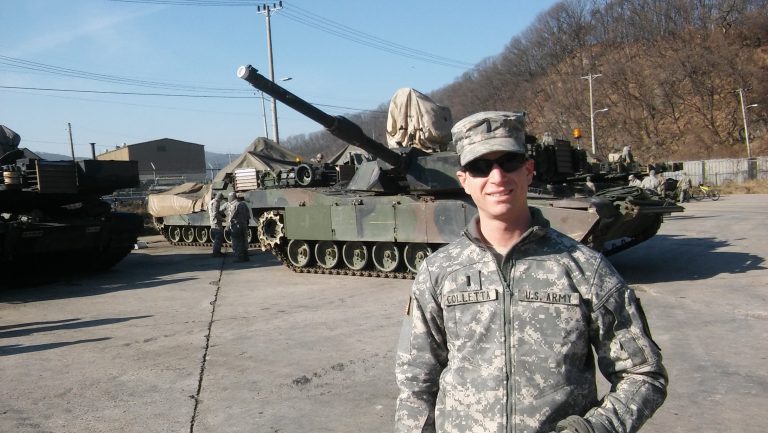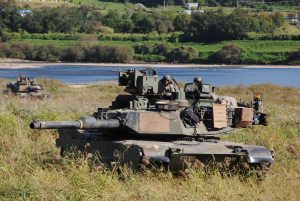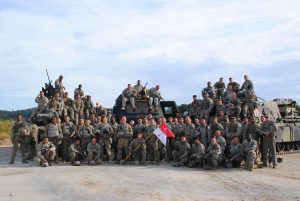Nuclear Weapons Policy from the Turret of a Tank
“Stop. Stop what you’re doing—put the machine guns back on the tanks and stand by, I’ll let you know if we’re drawing ammo.” In the pitch black night of August 4, 2015 our company commander told us that North Korean land mines had just exploded on the Demilitarized Zone, severing the legs of two South Korean soldiers who were patrolling the border. In the midst of parking our tanks after a month-long field exercise, the boys and I were hoping to get some proper sleep in our barracks rooms. Instead, I looked over at my platoon scampering around their turrets and thought, “Are we ready?” Having just spent so much time honing our marksmanship skills, I suppose we were as ready as we would ever be, but none of us truly understood how dim our prospects for survival were at the time.
I did not grow up in a military family like many of my peers, and there were certainly no Army uniforms to be seen in Delray Beach, Florida. I did, however, grow up with the wars in Iraq and Afghanistan being constantly beamed in to our living room. Inundated with images of what seemed to be the most pressing problem in the world, I wanted to contribute to their solution and, to my teenage self, the Army seemed to be the organization doing just that.

Colletta in front of his unit’s tanks, at the location where he received notice of the landmine explosion.
I spent four years at Vanderbilt University as an Army ROTC cadet, preparing to enter service as an officer and carry out counterinsurgency operations in the Middle East like my predecessors. But time passed and fate had different plans for me—the Iraq War officially ended in 2011 and troop levels in Afghanistan were declining precipitously by the time I commissioned in 2013. Instead of participating in the Global War on Terror, I was to serve on the last remaining front of the Cold War.
The Korean War—America’s longest war, no matter what the headlines have to say about Afghanistan—was well frozen when I arrived to Camp Casey with the 1st Cavalry Division in 2015. We all assumed it would stay that way. Despite our training, it was impossible to grasp the concept of potentially being the “speed bump” over which the Korean People’s Army (KPA) would steamroll on its way to Seoul… well, until that humid August night of the landmine incident, that is. We were told to call our families and then turn in our cell phones (“that’s when you know,” the old hands told us greenhorns) and maintained an extremely high level of alert over the following weeks while the two Koreas exchanged long-range artillery fire. We prepared for the worst.
So, what was the plan? In the event of the imminent outbreak of hostilities, our mission was to truck south to Seoul to provide manpower for the State Department’s Noncombatant Evacuation Operations (NEO). The idea was to get as many of the hundreds of thousands of Americans and other foreign nationals out of South Korea before everything “popped off.” But as we had just learned, that could happen at any moment. How we were supposed to accomplish our NEO mission after the first shot had been fired – operating under what could be the largest conventional and chemical munitions artillery barrage to date – truly vexed us.
Our second task was to mount up on our tanks and advance north behind the South Koreans as they took the fight to the KPA, with a mission to secure North Korean nuclear and biological weapons related facilities on the way. This was a more traditional mission for an armored unit like ours, but the Army’s conventional warfighting skills had atrophied during the Global War On Terror. My soldiers who had seen combat in the Middle East had only carried out counterinsurgency operations. In their experience, no American platoon sized element had been at risk of complete destruction by an enemy. What we were being asked to do was fight a “high intensity conflict” in which we planned around the destruction (read: violent death) of entire battalions and brigades (read: multiple thousands of American soldiers) in the first days and weeks, which themselves would be a fraction of the North and South Korean military and civilian casualties.
Cooler heads prevailed as officials negotiated a halt to the escalation, but the event I had just lived through would have far reaching effects. It completely froze all existing relations with the North and may have further supercharged its nuclear weapons development program. Not long after, on January 6, 2016, I was on the peninsula for what may have been North Korea’s first hydrogen bomb test. Its capabilities would rapidly increase in the coming years.
I went back to Camp Casey for a second tour in June 2017. The United States’ policy on the Korean Peninsula had just changed along with the new administration. “Strategic patience” had become “fire and fury” and every day I found myself providing analysis to friends and family back home as they witnessed Kim Jong-un and Donald Trump repeatedly threaten to incinerate millions of each other’s citizens with nuclear weapons. The strategic equation changed when North Korea claimed to have the capability to mount a thermonuclear warhead on an intercontinental ballistic missile that could reach the United States. And then:
BALLISTIC MISSILE THREAT INBOUND TO HAWAII. SEEK IMMEDIATE SHELTER. THIS IS NOT A DRILL.
We awoke on January 13, 2018 to an alert for the worst possible scenario: a North Korean nuclear attack on American soil. It was the scenario in which then-President Trump had made it expressly clear that he would “totally destroy North Korea,” the scenario in which we would go north first and ask questions later. The stories from Hawaii that day are harrowing: parents pulling over their cars and climbing into manholes with their children, people making what they thought were their final phone calls to loved ones, and the list goes on. Nearly 40 minutes passed before it was finally declared a false alarm, but the collective global gut check was impossible to ignore. This event would help me make concrete plans out of what had just been my private musings about my future.
While sitting in my barracks room overseas counting the days until my flight home, I wrestled with determining the impact of my work. Was I making a difference? I could assess the effects I had on my soldiers and unit, but if I was not there, would anything really change? I struggled to convince my soldiers (and myself, by extension) that the work we were asked to do at the ground level was essential to solving the geopolitical problem that was our raison d’être. I decided that it was time to take the many unique skills I learned in the Army (for which I will be forever grateful) and put them to use somewhere else.
In my search for post-Army careers, I came across 80,000 Hours’ career guide. An organization that promotes “effective altruism,” 80,000 Hours acts as a resource for those seeking to have as much of a positive impact on the world as possible with the 80,000 hours they have, on average, in their working life. I saw “nuclear security” listed on its website while reading about the world’s highest priority problem areas and realized that I had found my calling—it was almost too obvious.
The rest is history. I got out of the Army, road tripped the American West, moved to Paris to study international security at Sciences Po, and wound up at the Nuclear Threat Initiative through the Scoville Peace Fellowship. I am lucky to now spend my time promoting policies that may one day lead to a world free of nuclear weapons—a world where Koreans, Americans, and people everywhere need not be put at constant risk by such dangerous instruments. Looking back, I see that my journey instilled in me an urge to use what talents I have to make a positive impact on the world’s most pressing problems. That, I believe, is the common thread that runs through all Scoville Fellows, and I am grateful to be counted among them.
Christopher Colletta is a Spring 2021 Scoville Fellow at the Nuclear Threat Initiative.



